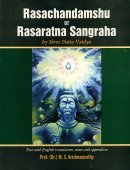Yakrit, Yakṛt: 13 definitions
Introduction:
Yakrit means something in Buddhism, Pali, Hinduism, Sanskrit, Marathi. If you want to know the exact meaning, history, etymology or English translation of this term then check out the descriptions on this page. Add your comment or reference to a book if you want to contribute to this summary article.
The Sanskrit term Yakṛt can be transliterated into English as Yakrt or Yakrit, using the IAST transliteration scheme (?).
In Hinduism
Ayurveda (science of life)
Source: Wisdom Library: Āyurveda and botanyYakṛt (यकृत्) refers to the “liver”. The term is used throughout Ayurvedic literature such as the Suśruta-saṃhitā and the Caraka-saṃhitā.

Āyurveda (आयुर्वेद, ayurveda) is a branch of Indian science dealing with medicine, herbalism, taxology, anatomy, surgery, alchemy and related topics. Traditional practice of Āyurveda in ancient India dates back to at least the first millenium BC. Literature is commonly written in Sanskrit using various poetic metres.
In Buddhism
Mahayana (major branch of Buddhism)
Source: Wisdom Library: Maha Prajnaparamita SastraYakṛt (यकृत्, “liver”) (Pali, Yakana) refers to one of the thirty-substances of the human body according to the Visuddhimagga, as mentioned in an appendix of the 2nd century Mahāprajñāpāramitāśāstra chapter 32-34. The Mahāprajñāpāramitāśāstra mentions thirty-six substances [viz., yakṛt]; the Sanskrit sources of both the Lesser and the Greater Vehicles, physical substances are 26 in number while the Pāli suttas list thirty-once substances.

Mahayana (महायान, mahāyāna) is a major branch of Buddhism focusing on the path of a Bodhisattva (spiritual aspirants/ enlightened beings). Extant literature is vast and primarely composed in the Sanskrit language. There are many sūtras of which some of the earliest are the various Prajñāpāramitā sūtras.
Languages of India and abroad
Marathi-English dictionary
Source: DDSA: The Molesworth Marathi and English Dictionaryyakṛt (यकृत्).—m n S The liver. 2 Inflammation of the liver, Hepatitis.
Source: DDSA: The Aryabhusan school dictionary, Marathi-Englishyakṛt (यकृत्).—m n The liver. Inflammation of the liver.
Marathi is an Indo-European language having over 70 million native speakers people in (predominantly) Maharashtra India. Marathi, like many other Indo-Aryan languages, evolved from early forms of Prakrit, which itself is a subset of Sanskrit, one of the most ancient languages of the world.
Sanskrit dictionary
Source: DDSA: The practical Sanskrit-English dictionaryYakṛt (यकृत्).—n. [yaṃ saṃyamaṃ karoti kṛ kvip tuk ca Tv.] The liver or any affection of it; सिन्धवो गुदा यकृच्च क्लोमानश्च पर्वताः (sindhavo gudā yakṛcca klomānaśca parvatāḥ) Bṛ. Up.1.1.1; Mv.3.32.
Source: Cologne Digital Sanskrit Dictionaries: Shabda-Sagara Sanskrit-English DictionaryYakṛt (यकृत्).—m. (-kṛt) The liver. E. ya union, (of the parts of the body,) kṛ to make, aff. kvip and tuk augment. yakan is optionally substituted for this word in some of the declensions.
Source: Cologne Digital Sanskrit Dictionaries: Benfey Sanskrit-English DictionaryYakṛt (यकृत्).—the base of many cases is optionally yakan yakan, n. The liver.
— Cf. [Latin] jecur; perhaps also [Anglo-Saxon.] lifer.
Source: Cologne Digital Sanskrit Dictionaries: Cappeller Sanskrit-English DictionaryYakṛt (यकृत्).—[neuter] the liver.
Source: Cologne Digital Sanskrit Dictionaries: Monier-Williams Sanskrit-English Dictionary1) Yakṛt (यकृत्):—n. (the weak cases are optionally formed [from] a base yakan cf. [Pāṇini 6-1, 63]; [nominative case] [accusative] yakṛt, [Atharva-veda]; [ablative] yaknas, [Ṛg-veda]; yakṛtas, [Suśruta]; [instrumental case] yaknā, [Vājasaneyi-saṃhitā]; [locative case] yakṛti, [Suśruta]; [in the beginning of a compound] only yakṛt) the liver, [Ṛg-veda]; etc.
2) cf. [Greek] ἧηπαρ; [Latin] jecur.
Source: Cologne Digital Sanskrit Dictionaries: Yates Sanskrit-English DictionaryYakṛt (यकृत्):—(t) 5. m. The liver.
Source: DDSA: Paia-sadda-mahannavo; a comprehensive Prakrit Hindi dictionary (S)Yakṛt (यकृत्) in the Sanskrit language is related to the Prakrit word: Jaga.
[Sanskrit to German]
Sanskrit, also spelled संस्कृतम् (saṃskṛtam), is an ancient language of India commonly seen as the grandmother of the Indo-European language family (even English!). Closely allied with Prakrit and Pali, Sanskrit is more exhaustive in both grammar and terms and has the most extensive collection of literature in the world, greatly surpassing its sister-languages Greek and Latin.
See also (Relevant definitions)
Starts with: Yakridari, Yakridatmika, Yakridiva, Yakridudara, Yakridvairin, Yakrita, Yakrithari, Yakritharilauha, Yakritka, Yakritkhandanibha, Yakritkhandatulya, Yakritkhandopama, Yakritkosha, Yakritpindasaprabha, Yakritplihari, Yakritplihodara, Yakritplihodarahara, Yakrittas, Yakrittu.
Ends with (+20): Abhamyakrit, Abhayakrit, Ahridyakrit, Apunyakrit, Bhashyakrit, Bhayabhayakrit, Bhayakrit, Dayakrit, Dhanyakrit, Hasyakrit, Hiranyakrit, Jayakrit, Karmanyakrit, Karyakrit, Kashayakrit, Krityakrit, Kshayakrit, Lepyakrit, Malyakrit, Mayakrit.
Full-text (+10): Jaga, Yakridatmika, Yakritka, Yakan, Yakridudara, Yakridvairin, Yakritkosha, Yakriddalyudara, Yakrilloma, Yakrin, Yakrid, Yakril, Yakrittas, Yakana, Yakriddalya, Yakrimedas, Yakridvarna, Jakrit, Yakirttucculai, Yakridvairi.
Relevant text
Search found 7 books and stories containing Yakrit, Yakṛt, Yakrt; (plurals include: Yakrits, Yakṛts, Yakrts). You can also click to the full overview containing English textual excerpts. Below are direct links for the most relevant articles:
Amarakoshodghatana of Kshirasvamin (study) (by A. Yamuna Devi)
Internal Anatomy < [Chapter 3 - Social Aspects]
Date of Kṣīrasvāmin < [Chapter 2 - Kṣīrasvāmin: Life and Works]
Maha Prajnaparamita Sastra (by Gelongma Karma Migme Chödrön)
Appendix 3 - Thirty-two substances of the human body < [Chapter XXXII-XXXIV - The eight classes of supplementary dharmas]
The Agni Purana (by N. Gangadharan)
Sushruta Samhita, Volume 6: Uttara-tantra (by Kaviraj Kunja Lal Bhishagratna)
Chapter XVII - Treatment of diseases of pupil and crystalline lens < [Canto I - Shalakya-tantra (ears, eyes, nose, mouth and throat)]
A History of Indian Philosophy Volume 2 (by Surendranath Dasgupta)
Part 3 - Organs in the Atharva-veda and Āyurveda < [Chapter XIII - Speculations in the Medical Schools]
Brihadaranyaka Upanishad (by Swāmī Mādhavānanda)
Related products

